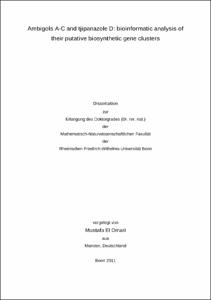Ambigols A-C and tjipanazole D: bioinformatic analysis of their putative biosynthetic gene clusters

Ambigols A-C and tjipanazole D: bioinformatic analysis of their putative biosynthetic gene clusters

| dc.contributor.advisor | König, Gabriele M. | |
| dc.contributor.author | El Omari, Mustafa | |
| dc.date.accessioned | 2020-04-17T06:34:22Z | |
| dc.date.available | 2020-04-17T06:34:22Z | |
| dc.date.issued | 04.08.2011 | |
| dc.identifier.uri | https://hdl.handle.net/20.500.11811/5020 | |
| dc.description.abstract | Cyanobacteria are Gram negative, photoautotrophic bacteria, which are distinguished by an impressive array of chemically diverse natural products. The here investigated cyanobacterial strain of Fischerella ambigua was shown to produce the phenolic compounds ambigols A-C and the indol alkaloid tjipanazole D. The current work focused on sequence information related to the ambigol and tjipanazole D biosynthetic gene clusters and its annotation using bioinformatic tools. First, a fosmid library of the F. ambigua genome had to be established. Subsequently, the genomic library was screened for halogenase genes and fosmid E8 was identified as possibly harbouring ambigol related biosynthetic genes. Data missing on fosmid E8 were subsequently obtained from a 454 sequencing of the F. ambigua genome, in that contig 00522 with a size of approximately 123 kb confirmed and completed the sequences found on fosmid E8. Using bioinformatic tools the sequence information was analysed for the putative function of the respective proteins. Thus, the putative ambigol biosynthetic gene cluster (size = 13 kb) comprises seven genes encoding enzymes that would be expected regarding the structural features of ambigols. These enzymes were a 4-hydroxybenzoate (4-HBA) synthetase that is possibly involved in the formation of the starter molecule via the shikimate pathway, an AMP-ligase putatively activating the starter molecule, an NRPS module that may serve as a carrier protein for the activated starter unit. Two CYP 450 enzymes and two halogenases are proposed to mediate the following biosynthesis steps, i.e. phenolic oxidative coupling and aromatic moiety chlorination. The putative tjipanazole D biosynthetic gene cluster (size = 12 kb) was identified on contig 15287, which has a size of approximately 59 kb. It was also obtained by 454 sequencing and bears all sequence information on genes probably related to the tjipanazole D production. Based on the highly conserved biosynthetic pathways for the indolocarbazoles rebeccamycin, staurosporine, an assignment of all genes of the tj operon was possible. Similar to the rebeccamycin biosynthetic gene cluster, a set of five genes is putatively responsible for tjipanazole D formation. These are proposed to encode an L-tryptophan halogenase, an L-tryptophan oxidase, a chromopyrrolic acid synthase-like protein, a CYP 450 enzyme and an FAD-binding monooxygenase. Whereas the halogenase is proposed to chlorinate free tryptophan, the other four enzymes most likely mediate the assembly of the indolocarbazole skeleton. | |
| dc.language.iso | eng | |
| dc.rights | In Copyright | |
| dc.rights.uri | http://rightsstatements.org/vocab/InC/1.0/ | |
| dc.subject | Halogenation | |
| dc.subject | chlorination | |
| dc.subject | biosynthesis | |
| dc.subject | indolocarbazole | |
| dc.subject | shikimate pathway | |
| dc.subject | shikimic acid | |
| dc.subject | halogenases | |
| dc.subject | flavin | |
| dc.subject | FADH2 | |
| dc.subject | chorismic acid | |
| dc.subject | chromopyrrolic acid | |
| dc.subject | genomic library | |
| dc.subject | pcr screening | |
| dc.subject | shotgun library | |
| dc.subject | cytochrome p450 | |
| dc.subject | phenolic oxidative coupling | |
| dc.subject | tailoring | |
| dc.subject | modification | |
| dc.subject | side chain | |
| dc.subject | dimerization | |
| dc.subject | tryptophan | |
| dc.subject | 4-hydroxybenzoic acid | |
| dc.subject | decarboxylation | |
| dc.subject | ambigols | |
| dc.subject | tjipanazole D | |
| dc.subject | bisindole | |
| dc.subject | hypothesis | |
| dc.subject | bioinformatic analysis | |
| dc.subject | software | |
| dc.subject.ddc | 500 Naturwissenschaften | |
| dc.subject.ddc | 540 Chemie | |
| dc.subject.ddc | 570 Biowissenschaften, Biologie | |
| dc.subject.ddc | 610 Medizin, Gesundheit | |
| dc.title | Ambigols A-C and tjipanazole D: bioinformatic analysis of their putative biosynthetic gene clusters | |
| dc.type | Dissertation oder Habilitation | |
| dc.publisher.name | Universitäts- und Landesbibliothek Bonn | |
| dc.publisher.location | Bonn | |
| dc.rights.accessRights | openAccess | |
| dc.identifier.urn | https://nbn-resolving.org/urn:nbn:de:hbz:5N-26122 | |
| ulbbn.pubtype | Erstveröffentlichung | |
| ulbbnediss.affiliation.name | Rheinische Friedrich-Wilhelms-Universität Bonn | |
| ulbbnediss.affiliation.location | Bonn | |
| ulbbnediss.thesis.level | Dissertation | |
| ulbbnediss.dissID | 2612 | |
| ulbbnediss.date.accepted | 25.07.2011 | |
| ulbbnediss.fakultaet | Mathematisch-Naturwissenschaftliche Fakultät | |
| dc.contributor.coReferee | Knöss, Werner |
Dateien zu dieser Ressource
Das Dokument erscheint in:
-
E-Dissertationen (4077)




